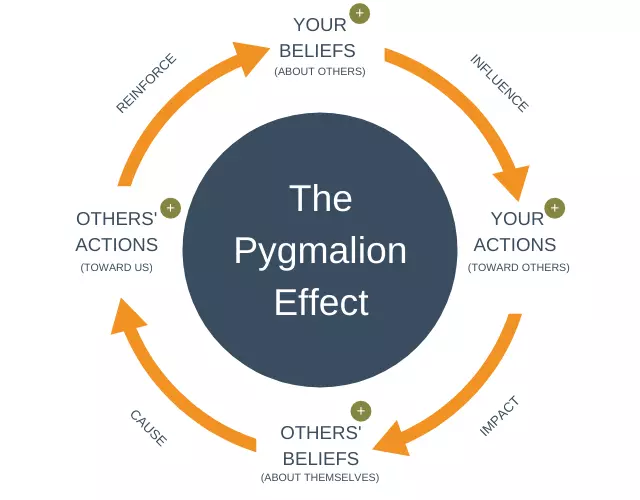Comments
- No comments found

Pygmalion in the Classroom, one of the most controversial publications in the history of educational research, showed how a teacher’s expectations can motivate student achievement.
This classic study gave prospective teachers a list of students who had been identified as “high achievers.” The teachers were told to expect remarkable results from these students, and at the end of the year, the students did indeed make sharp increases on their test scores.
In reality, these children were not high achievers, but had been chosen at random from the entire pool of pupils. It was the teachers’ belief in their potential that was responsible for their exceptional results; a belief that was communicated not directly (the students were never told they were special), but subliminally through nonverbal cues.

In much the same way, a leader’s expectations of employees is also a key factor in how well people perform at work. Positive Pygmalion leadership is in operation when staff excels in response to the manager’s message that they are capable of success and expected to succeed. This effect was described in a Psychology Today article, Pygmalion Leadership: The Power of Positive Expectations: "The way managers treat their subordinates is subtly influenced by what they expect of them.”
Body language is the management of time, space, appearance, posture, gesture, touch, expression, eye contact, and vocal prosody -- how you say what you say. From a body language perspective, teachers (and business leaders) encourage positive behaviors when they give their teams undivided attention, eye contact, smiles, nods, warm vocal tones, and the slight forward leans that signal engagement.
Of course, we’ve all seen instances where the reverse is true – where a leader’s nonverbal communication undermines staff performance and lowers productivity.
Take, for example, this email I received: My boss drives us crazy with her mixed messages. She says things like, "You are always welcome in my office" and “You are all an important part of the team.” At the same time, her nonverbal communication is constantly showing how unimportant we are to her. She never makes eye contact, will shuffle papers when others talk, writes emails while we answer her questions and generally does not give her full attention. In fact, we don’t even rate her half attention! Then she wonders why we’re all so demoralized.
I invite you to try this: Imagine that you just found out that everyone on your team has been identified as a high achiever. And imagine that this was a secret you couldn’t share with them – except through your body language. How would you let people know they were special?
Once you get a good idea of what you’d do, take one full week and non-verbally treat everyone who works for or with you as if they were potential stars. See if at least some of them don’t start living up to the high expectations your body language signals send.
Carol is an international keynote speaker at conferences, business organizations, government agencies, and universities. She addresses a variety of leadership issues, but specializes in helping leaders build their impact and influence skills for fostering collaboration, building trust, and projecting that illusive quality called "leadership presence." She is the author of "STAND OUT: How to Build Your Leadership Presence." and the creator of LinkedIn Learning's video course, "Body Language for Leaders." Carol completed her doctorate in the United States. She can be reached at http://CarolKinseyGoman.com
Leave your comments
Post comment as a guest